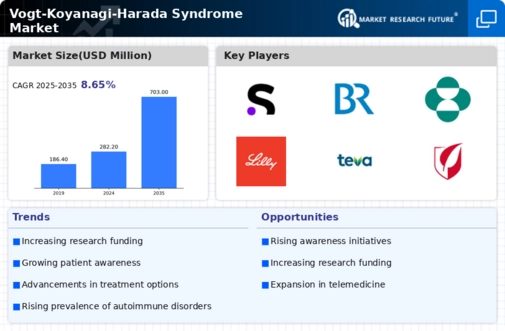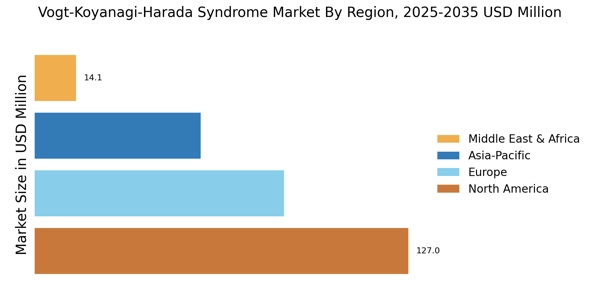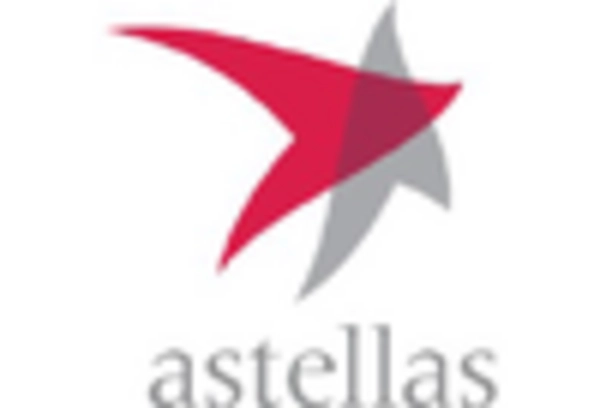Advancements in Treatment Modalities
Innovations in treatment modalities for Vogt-Koyanagi-Harada Syndrome are significantly influencing the Vogt-Koyanagi-Harada Syndrome Market. Recent advancements in immunosuppressive therapies and biologics have shown promise in managing the symptoms and progression of the disease. These new treatment options are likely to improve patient outcomes and enhance quality of life. Furthermore, the introduction of targeted therapies may lead to more personalized treatment approaches, which could attract a broader patient base. As healthcare providers become more familiar with these advancements, the adoption of novel therapies is expected to increase, thereby driving market growth. The ongoing research into the efficacy and safety of these treatments will also play a crucial role in shaping the future landscape of the market.
Regulatory Support and Policy Changes
Regulatory support and policy changes are emerging as influential drivers in the Vogt-Koyanagi-Harada Syndrome Market. Governments and regulatory bodies are increasingly recognizing the need for improved treatment options for rare diseases, including Vogt-Koyanagi-Harada Syndrome. This recognition may lead to expedited approval processes for new therapies, thereby facilitating quicker access for patients. Additionally, policy changes aimed at enhancing healthcare access and affordability can significantly impact the market landscape. As more patients gain access to necessary treatments, the demand for therapies is expected to rise. This supportive regulatory environment could encourage pharmaceutical companies to invest in the development of new products, ultimately benefiting the overall market.
Investment in Research and Development
Investment in research and development for Vogt-Koyanagi-Harada Syndrome is a significant factor influencing the Vogt-Koyanagi-Harada Syndrome Market. Pharmaceutical companies and research institutions are increasingly allocating resources to explore new therapeutic avenues and improve existing treatment protocols. This focus on R&D is essential for discovering novel drugs and treatment strategies that can effectively address the complexities of the syndrome. The potential for breakthroughs in understanding the pathophysiology of the disease may lead to the development of more effective therapies. As funding for research initiatives continues to grow, the market is likely to benefit from the introduction of innovative solutions that can enhance patient care and outcomes.
Growing Awareness and Education Initiatives
The rise in awareness and education initiatives surrounding Vogt-Koyanagi-Harada Syndrome is a critical driver for the Vogt-Koyanagi-Harada Syndrome Market. Increased efforts by healthcare organizations and patient advocacy groups to educate both the public and medical professionals about the syndrome are likely to lead to earlier diagnosis and treatment. This heightened awareness can result in a larger patient population seeking care, which in turn drives demand for therapeutic options. Educational campaigns that focus on the symptoms and potential complications of the syndrome may encourage individuals to seek medical advice sooner. As more healthcare providers become knowledgeable about the condition, the likelihood of appropriate referrals and treatment increases, further propelling market growth.
Rising Incidence of Vogt-Koyanagi-Harada Syndrome
The increasing incidence of Vogt-Koyanagi-Harada Syndrome is a notable driver in the Vogt-Koyanagi-Harada Syndrome Market. Recent studies indicate that the prevalence of this autoimmune condition is on the rise, particularly among individuals of Asian descent. This trend suggests a growing patient population that requires effective treatment options. As awareness of the syndrome expands, healthcare providers are more likely to diagnose and treat affected individuals, thereby increasing demand for therapeutic interventions. The market is projected to experience growth as more patients seek medical attention, leading to a higher utilization of available therapies. This rising incidence not only highlights the need for innovative treatment solutions but also emphasizes the importance of ongoing research to better understand the underlying mechanisms of the disease.


















Leave a Comment